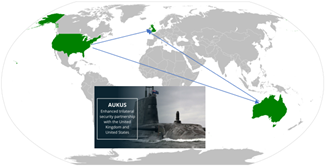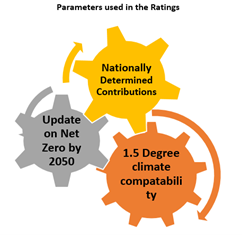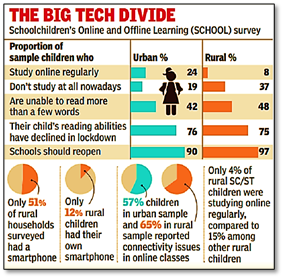Tuesday, 21st September 2021
The Global Innovation Index 2021
In News
The Global Innovation Index (GII) 2021 has been recently released by the World Intellectual Property Organization (WIPO).
About the News
- Consistent Rise in India’s rank: India has climbed two spots to 46 in the Global Innovation Index (GII) 2021. India’s rank has been consistently rising in the last few years. From 81 in 2015, it has moved to 46 in 2021.
- Reasons for the rise: The consistent rise is due to the immense knowledge capital, the vibrant start-up ecosystem, and work done by research organizations.
- Top Rankings across Sectors: India has been portrayed as successful in developing sophisticated services that are technologically dynamic and can be traded internationally. It is reflected in the some top rankings as:
- Information and communication technology services exports indicator - Rank 1
- Domestic industry diversification – Rank 12
- Graduates in science and engineering- Rank 12.
- Support System: Department of Atomic Energy, the Department of Science and Technology, the Department of Biotechnology and the Department of Space also played a pivotal role in improving the ranking.
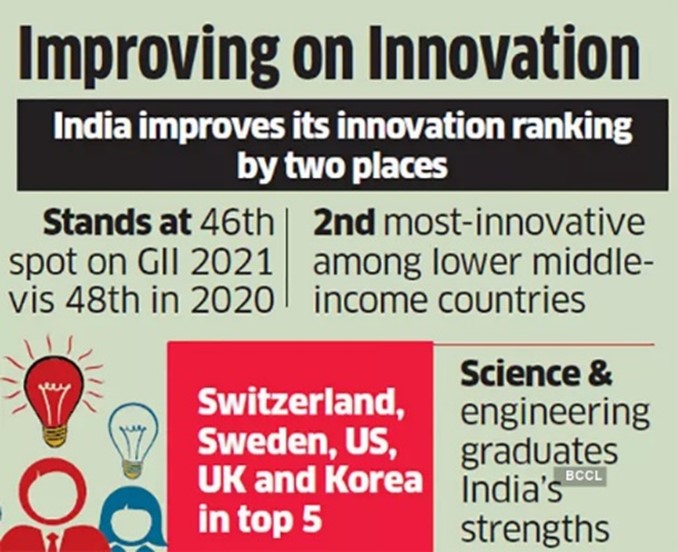
-
- A constant thrust on monitoring and evaluating India’s position in the global rankings has been provided by the NITI Aayog.
About the index
- Organization: The index is prepared by World Intellectual Property Organization (WIPO).
- About: It provides new data and analysis on the state of global innovation, and allows readers and policy-makers to benchmark the innovation ecosystem performance of more than 130 economies.
- Indicators: The index ranks world economies according to their innovation capabilities and consists of roughly 80 indicators.
- Innovation Parameter: WIPO’s criteria to measure innovation cover institutions, human capital and research, infrastructure, credit, investment, linkages, creation, absorption and diffusion of knowledge, and creative outputs.
- New Feature: A new feature was added this year which is the Global Innovation Tracker.
- It gives a snapshot on the pulse of global innovation, including throughout the Covid-19 pandemic

Sources:
Recent Telecom industry announcements
In News
The government has made important announcements to provide relief to the telecom sector.
Major Announcements and their impacts
What can be the further Reforms based on these announcement?
- Reduction in Reserve Price: Reduction in the reserve price of the various spectrum bands, consistent with international bench mark prices.
- Average reserve price fixed by the government of India for auctions in February 2021 was several times higher than that set internationally.
- Investment in Infrastructure: Companies should invest in access and backhaul network infrastructure.
- Adoption of Technologies: Companies should adopt technologies such as voice over wi-fi to provide enhanced and superior connectivity to their deserving customers.
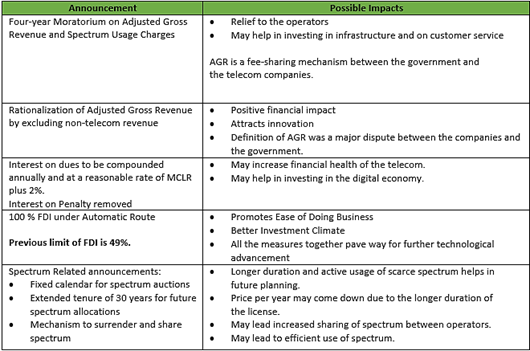
Sources:
Urban Planning
In News
The report, titled ‘Reforms in Urban Planning Capacity in India’, was recently released by NITI Aayog.
Setting the Context
- India is the second largest urban system in the world with almost 11% of the total global urban population living in Indian cities.
- The country has reached a turning point in its journey of its economic transformation wherein half of the country would be ‘urban’ in a few decades. Urban growth is expected to contribute to 73% of the total population increase by 2036 (MoHFW, 2019).
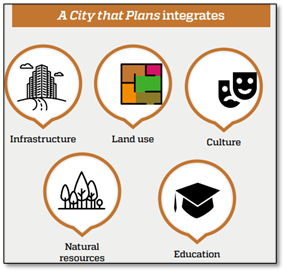
What is Urban Planning?
Urban planning is the process that seeks to control the development of cities through local regulations and direct interventions, to fulfill a number of objectives, such as mobility, quality of life and sustainability.
Need for reforming urban planning capacity
- Expanding Cities: Over the years, cities have expanded and become burdened by the stresses and strains of unplanned urbanization, the brunt of which is faced by the poor and the marginalised, the biodiversity and the economy.
- Increasing urban Population: The United Nations in 2019 estimated that India will to surpass China as the world’s most populous country by 2027. These census towns contributed over 30% of the net increase in urban population between 2001 and 2011—indicating the nature of transformation that is taking place in the rural areas.
- Urbanisation is Central to India’s Economy: MoHUA (2016) stated that urbanisation contributes nearly 60% to India’s Gross Domestic Product (GDP). There are some studies that attest linkages between urbanisation and per capita GDP and India is behind other large Asian economies.
- India’s Global Commitments: Cities play a decisive role in achieving India’s commitments to global agendas, such as United Nation’s Sustainable Development Goals (Goal 11 - making cities inclusive, safe, resilient, and sustainable) and UN-Habitat’s New Urban Agenda.
- India’s National Growth Targets: Several growth targets of India reflect the need for concerted action for fulfilling the full potential of the urban economy. For example
- Economic growth target: USD 5 trillion economy by 2024
- Employment target: Total workforce estimated to be 0.64 billion by 2030, of which 0.26 billion to be employed in urban areas.
- Infrastructure targets: Creation of 11 large industrial corridors as part of the National Industrial Corridor Programme, several multi-modal logistic parks, etc.
- Environmental protection targets: River rejuvenation, clean air in cities, etc.
- City Planning for Disaster Mitigation: The way urban areas are planned, developed, and managed; can create long lasting impacts on the local water availability and vulnerability to disasters. Example: The floods in Chennai in the year 2015.
- The approach towards natural drainage systems, wetlands, floodplains, surface waterbodies and ground water while planning of cities and regions plays an integral role in maintaining the water balance, flood cushioning, micro-climate regulation and protection of biodiversity
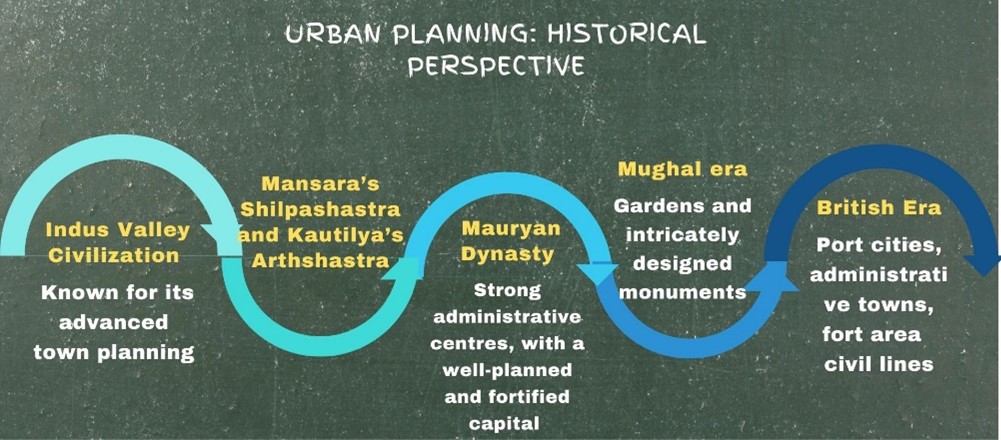
Key Challenges to Urban Planning
- Unrecognized Urban Areas: A significant proportion of urbanization in the country is unacknowledged and unaddressed. The current definitions of ‘urban’ are not reflective of the extent of urbanization that the country has already witnessed.
- Administrative Issues: There are multiple institutions and parastatals working simultaneously, leading to ambiguity, overlaps and even discord over division of functions and responsibilities.
- Parastatals may take the form of urban development authorities and public corporations. These agencies are accountable only to the State government, not the local government.
- Lack of Human Resources: An inadequate number of urban planners in the State planning machineries and lack of multi-disciplinary teams are serious issues. In some States/UTs, degree is not considered as mandatory eligibility criteria for the domain of town/urban planning.
- Meagre citizen Participation: The platforms for citizen participation and their awareness about the process of urban planning and development are limited. There is communication gap between planning agencies and the people.
- Lack of Revenues: The 74th amendment Act left the notification of the urban local body at the discretion of the Governor of the States. However, it did not lay down a revenue base for the ULBs. ULBs have to depend on state governments for their finances.
- Leadership problems: In most Indian cities, the mayor is endowed with limited executive responsibilities. Also, the mayor’s tenure varies from one State to another and ranges from 1 to 5 years. Mayors remain titular heads with more powers with the Municipal Commissioners who are appointed by the State.
What are the recommendations of the NITI Aayog on Urban Planning?
The Advisory Committee focused on devising measures to strengthen the three pillars of cumulative urban planning capacity in the country: public sector, education/ research sector, and private sector. And on identifying ways to create a robust feedback loop that helps one pillar strengthen the other.
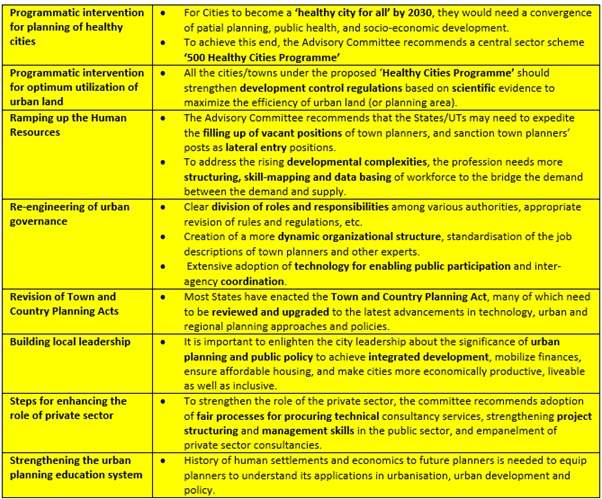
Conclusion: Urbanization is intrinsic to development and often serves as a major driver of economic growth. As India reaches tipping point of transitioning from a mostly rural to an urban society, the focus must be on ensuring the best opportunities for economic growth for all sections of the society. The need of the hour is incisive, insightful planning – in the absence of which neither investments nor actions would be able to yield long-term solutions. Unplanned urbanization could result in serious downsides.
Question: Explain the need for developing an effective urban planning. Discuss the challenges to urban planning and ways to resolve these challenges.
Sources:
Cumbre Vieja volcano
This is image of the volcanic eruption of the Cumbre Vieja volcano. Cumbre Vieja volcano erupted on Spain's Canary Island of La Palma, spewing out lava, ash and a huge column of smoke after days of increased seismic activity. La Palma, with a population of 85,000, is one of the eight volcanic islands in Spain’s Canary Islands archipelago off Africa’s western coast. La Palma had been on high alert after more than 22,000 tremors were recorded in one week around the volcano. Cumbre Vieja last erupted in 1971 and in 1949.

Sources:
Border Outposts (BOPs)
- Context: Failure of the all-weather integrated border outposts (BOPs).
- The project for constructing all-weather roads involved construction of over 40 integrated Border Outposts (BOPs) for the troops guarding the Line of Actual Control (LAC)
- The project was announced in 2015 with an aim to improve border infrastructure for troops on the frontline.
- These BOPs were the first of their kind in the region with freeze-proof toilets, running water and temperature maintained above 22 degree Celsius at all times.
- The first BOP, as a pilot for the project, was sanctioned to be built for the Indo-Tibetan Border Police (ITBP) in Lukung, on the western bank of Pangong Tso.
- The project was awarded to National Projects Construction Corporation (NPCC), a PSU under the Ministry of Jal Shakti.
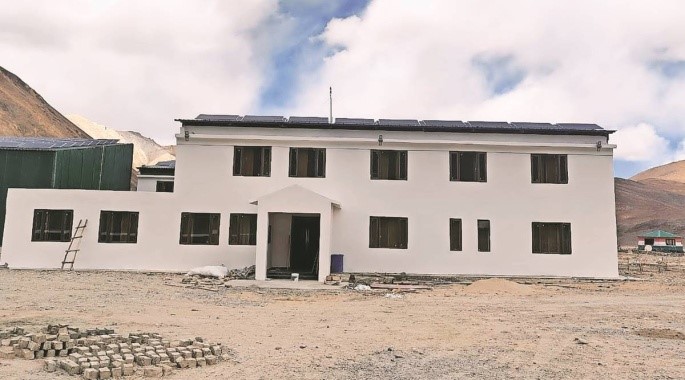
Sources:
- All-weather border outposts: Ministries in blame game as Ladakh project fails
- All-weather border outposts: After Ladakh project failure, ITBP looks for new agency to complete pending work
Image source:
Humboldt penguins
- Context: Mumbai’s Byculla Zoo has announced the addition of two new Humboldt penguin chicks.
- Humboldt penguins (Spheniscus humboldti) are medium-sized penguins that belong to a genus known as the ‘banded’ group.
- These are among at least 17 species of penguins and are endemic to the Pacific coasts of Chile and Peru.
- Humboldt penguins have an average height of just over 2 ft.
- They are so named because their habitat is located near the Humboldt Current, a large oceanic upwelling characterized by cold waters.
- Humboldt penguins have large, bare skin patches around their eyes, an adaptation to help keep them cool. They are most popular zoo penguins due to its ability to withstand warmer climates.

Source:
Delhi-Mumbai Expressway
• Context: The Union Minister for Road Transport and Highways has recently reviewed the work progress on the Delhi-Mumbai Expressway.
• The Expressway is a 1380-km long eight-lane expressway passing through Delhi, Haryana, Rajasthan, Madhya Pradesh and Gujarat which is expected to reduce travel time between the cities to 12 hours from 24 hours.
• The project kickstarted in 2018 and is expected to be completed by March 2023.
• The expressway will improve connectivity to economic hubs like Jaipur, Udaipur, Bhopal, Ahmedabad etc.
• The expressway is the first in Asia and only the second in the world to feature animal overpasses to facilitate unrestricted movement of wildlife.
• The expressway will include two iconic 8-lane tunnels, one tunneling through Mukundra sanctuary and the other through the Matheran eco-sensitive zone.
• The expressway will result in annual fuel savings of more than 320 million litres and reduce CO2 emissions by 850 million kg which is equivalent to the planting of 40 million trees
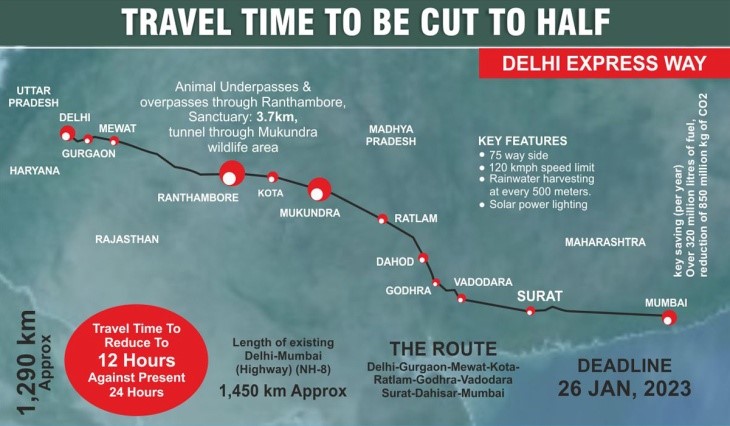
Source:
Image source:
Rail Kaushal Vikas Yojana
• Context: The Union Minister for Road Transport and Highways has recently reviewed the work progress on the Delhi-Mumbai Expressway.
• The Expressway is a 1380-km long eight-lane expressway passing through Delhi, Haryana, Rajasthan, Madhya Pradesh and Gujarat which is expected to reduce travel time between the cities to 12 hours from 24 hours.
• The project kickstarted in 2018 and is expected to be completed by March 2023.
• The expressway will improve connectivity to economic hubs like Jaipur, Udaipur, Bhopal, Ahmedabad etc.
• The expressway is the first in Asia and only the second in the world to feature animal overpasses to facilitate unrestricted movement of wildlife.
• The expressway will include two iconic 8-lane tunnels, one tunneling through Mukundra sanctuary and the other through the Matheran eco-sensitive zone.
• The expressway will result in annual fuel savings of more than 320 million litres and reduce CO2 emissions by 850 million kg which is equivalent to the planting of 40 million trees.
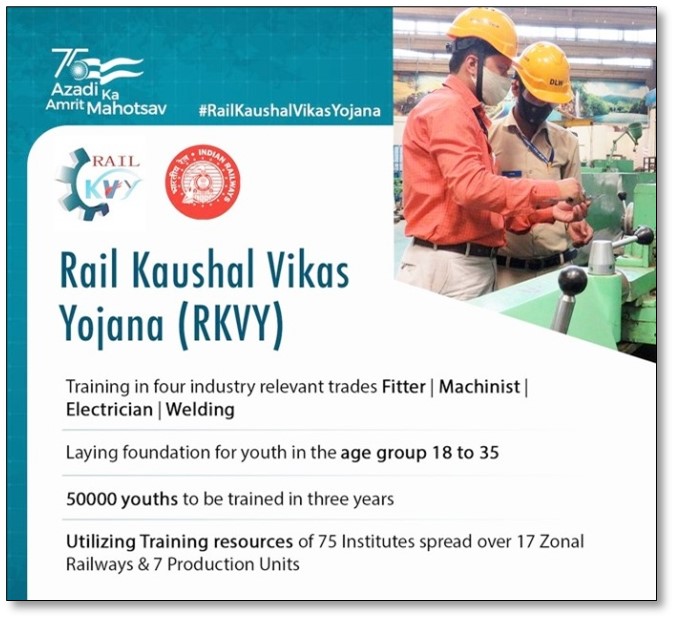
Source:
- Railway-focused skill development programme launched under PMKVY
- Indian Railways to train 50,000 youths under 'Rail Kaushal Vikas Yojana'. Check eligibility and other details:
- Rail Kaushal Vikas Yojana
Maharaja Sawai Jai Singh II
On September 21, 1743, Maharaja Sawai Jai Singh II died. Sawai Jai Singh II, the remarkable Monarch of Jaipur, was a mathematician, an astronomer, and a town planner par excellence. He set up the famous observatories known as Jantar Mantars and built the city of Jaipur. Maharaja Sawai Jai Singh II (1686-1743) was the ruler of the Rajput State of Amber. A feudatory of the Mughals, he received the title of 'Sawai' (one and a quarter) from Emperor Aurangzeb.

Sources:
Why the farmers’ movement must broaden its agenda
Essence: Article connects various social agitations with identity and aspirational crisis of landholding farming community who are disillusioned now, as they could not get appropriate job even after attaining higher education.
It points out that recent political efforts to undermine farmers' protests and dilution of laws related to land acquisition, which are possibly a part of deeper design to undercut the hold of farmers in the political, especially electoral, discourse.
Article reminds farmers about the potential of the movement, given the unprecedented solidarity received by these protests from other social movements and trade movements. It prescribes that it is time to build a bigger coalition by widening the agenda of movements to include difficult conversations about caste and gender hierarchies in the agrarian social structure, and the prevailing ecologically unsound land-use patterns.
Why you should read this article:
- To understand the core issues leading to farming community unrest and resultant protests
- To understand the motives behind the recent legislations related to agriculture or farming community
Source:
The new AUKUS alliance holds some lessons for India
Essence: Recently, the US, the UK, and Australia joined hands to form a strategic alliance in which the US and the UK will share intelligence and advanced technologies in areas like artificial intelligence, cyber-warfare, quantum computing, and nuclear submarine construction with Australia. The AUKUS alliance was more or less predictable because of the three countries sharing strategic alliances like NATO, ANZUS, etc. The AUKUS leaves China in doubt that if the formation of AUKUS is similar to a Cold War strategy, which led to the disintegration of the USSR, against China.
AUKUS also seems an “exclusionary bloc,” which is symbolic of India and Japan not being members of AUKUS. The alliance can also be a concern for India and will need insurance against hegemony. The editorial also tries to indicate India to be cautious of its bilateral relationship with the USA. Concern for India also arise due to the transfer of advanced technology and nuclear submarine to Australia.
Why you should read this article?
- To understand what is the new alliance between the US, the UK, and Australia.
- To understand how the formation of the AUKUS alliance will impact Asia’s geopolitics.
Source:
Fund and faculty’ count in higher education rankings- TH
Essence: The most useful (but ignored so far) purpose of the ranking the educational institutions, as highlighted by the National Institutional Ranking Framework (NIRF) for higher education, is to identify areas of improvement and overcome those deficiencies to ensure quality and promote excellence. To make this happen, universities need to contribute to research, publications, patents and innovations. Since, the universities are ranked on a metric of measures, NIRF accords 30% weightage to Research and Performance and Professional Practices (RPP). But the top-ranking universities show an upsetting trend of the research performance. Also, the survey discloses how the higher expenditure on salaries of the staff, presence of research scholars and ranking of the universities are inter-related. Sadly, these remain among of the most neglected areas for education reforms in the country.
Why should you read this article?
- To get an idea about NIRF and how it functions.
- To know what possible steps universities need to take to ensure quality and promote excellence in higher education.
Source:
Teacher as Innovator
Background
- Resource constraints: Online teaching during pandemic needed tripod stand, black board installation, smart phones and many teachers couldn’t afford it.
- Delivery of Class: explaining through writing became a practical challenge.
Value in Creativity
- Device: A govt teacher from Nalgonda district of Telangana invented a device to address this constraint.
- Resourcefulness: He created an innovate a low-cost stand that would hold the phone on a glass table and focus on a sheet of paper.
- Demand: This led to the product orders from other teachers in the region.
Quote:
“The role of the teacher is to create the conditions for invention rather than provide ready-made knowledge”.- Seymour Papert
Source:
Share the article
Get Latest Updates on Offers, Event dates, and free Mentorship sessions.

Get in touch with our Expert Academic Counsellors 👋
FAQs
UPSC Daily Current Affairs focuses on learning current events on a daily basis. An aspirant needs to study regular and updated information about current events, news, and relevant topics that are important for UPSC aspirants. It covers national and international affairs, government policies, socio-economic issues, science and technology advancements, and more.
UPSC Daily Current Affairs provides aspirants with a concise and comprehensive overview of the latest happenings and developments across various fields. It helps aspirants stay updated with current affairs and provides them with valuable insights and analysis, which are essential for answering questions in the UPSC examinations. It enhances their knowledge, analytical skills, and ability to connect current affairs with the UPSC syllabus.
UPSC Daily Current Affairs covers a wide range of topics, including politics, economics, science and technology, environment, social issues, governance, international relations, and more. It offers news summaries, in-depth analyses, editorials, opinion pieces, and relevant study materials. It also provides practice questions and quizzes to help aspirants test their understanding of current affairs.
Edukemy's UPSC Daily Current Affairs can be accessed through:
- UPSC Daily Current Affairs can be accessed through Current Affairs tab at the top of the Main Page of Edukemy.
- Edukemy Mobile app: The Daily Current Affairs can also be access through Edukemy Mobile App.
- Social media: Follow Edukemy’s official social media accounts or pages that provide UPSC Daily Current Affairs updates, including Facebook, Twitter, or Telegram channels.

